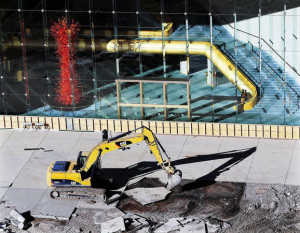A closer look at civil engineering
 Arguably, civil engineering is the oldest form of engineering. We can imagine it began the first time one of our ancestors laid a log across a river to make a bridge, or made some kind of cover over their head to protect themselves against the rain.
Arguably, civil engineering is the oldest form of engineering. We can imagine it began the first time one of our ancestors laid a log across a river to make a bridge, or made some kind of cover over their head to protect themselves against the rain.
Ancient civilizations are remembered by their civil engineering accomplishments. In ancient Egypt, Mesopotamia, the Indus Valley, the first civil engineers built shelters and other structures on an ever larger scale. Their work made possible transportation, as well as water control and distribution.
History of civil engineering
One of first large-scale construction projects was the pyramids and temple structures. There were also the canals and water management systems in Mesopotamia, the Parthenon in ancient Athens, Roman roads across Europe and Asia Minor, The Great Wall of China, and the irrigation works in Anuradhapura, the ancient kingdom in today’s Sri Lanka.
The Institution of Civil Engineers was founded as the first association of the profession in London in 1818. Its charter defined civil engineering as:
the art of directing the sources of power in nature for the use and convenience of man, as the means of production and of traffic … as applied in the construction of roads, bridges, aqueducts, canals, river navigation and docks … and in the construction of ports, harbours, moles, breakwaters and lighthouses, and in the art of navigation by artificial power for the purposes of commerce, and in the construction and application of machinery, and in the drainage of cities and towns.
As you can see, it’s a pretty broad list of the things we do to build our environment to suit our needs and purposes.
Types of civil engineers
Civil engineering today encompasses a number of sub-disciplines, or specializations within the field of civil engineering. These include:
- Construction engineering — focused on planning and carrying out the actual building of structures, as well as the logistics and transportation of construction materials, site development, hydraulic, environmental and geotechnical engineering.
- Geotechnical engineering — the study of rock and soil to ensure the ground can support the structures planned. It also works to protect ground water and maintain landfills.
- Earthquake engineering — designing structures to withstand the stresses and shaking of earthquakes.
- Coastal engineering — focused on managing coastlines and shorelines. Defending against and reducing flooding and erosion are the main focuses.
- Environmental engineering — the modern term for “sanitary engineering,” deals with water once it’s been used for drinking, washing or flushing. Go ahead. Try to get by without it.
- Materials science and engineering — studies the basic characteristics of materials including metals, concrete, ceramics and aggregates.
Some classify structural engineering and surveying as sub-disciplines of civil engineering, but they are specialized enough to qualify as categories of engineering in their own right.
Where it’s used
Civil engineering, though, is not only about buildings and large structures that can be seen from orbit. Civil engineering is also essential to aerospace, automotive and other types of manufacturing, traffic flows, city designs — just about any place where humans attempt to shape the world to their own needs.
What a civil engineer does
According to the U.S. Bureau of Labor Statistics, civil engineers “design, construct, supervise, operate and maintain large construction projects and systems, including roads, buildings, airports, tunnels, dams, bridges, and systems for water supply and sewage treatment.”
At McNeil Engineering, our civil engineering team provides site engineering design as well as civil engineering. We do site feasibility studies, due diligence analysis, site layout, road design, grading design, earthwork analysis and drainage analysis.
Our civil engineers also are concerned with storm water detention systems, sanitary sewer systems, erosion control, and overall design of subdivisions.
The civil engineer’s work extends beyond the construction site, however. The civil engineer is essential to design of urban subdivisions, developing 3D digital models, and managing a number of different government permits, licenses and relationships with various agencies.
Civil engineering around us
McNeil Engineering has a long history in civil engineering projects, particularly in and around Salt Lake City.
For example, our civil engineers were part of the design team that redeveloped the historic Enos Wall Mansion in downtown Salt Lake City. We completed the paving and horizontal control plan, which included design of the street edge, pavement and sidewalks, as well as storm water drainage report, storm water detention system, site utility plan and erosion control plan.
When the Abravanel Hall concert venue in Salt Lake City needed a new entry plaza, we worked with the architects to complete the grading and drainage design, designed a retaining wall, devised the erosion control plan and designed the storm water collection system.
We also provided all the surveying and civil engineering for the expansion of the Fashion Place Mall in Murray, Utah, that began in 2005 and continued through 2016. When completed, the mall included one million square feet of retail space. Our civil engineering work included design for the roadways, parking lots, sidewalks and plazas, grading and drainage, water system and sanitary sewers.
Get the answers for your next project
Your next construction project needs the best possible site design, erosion control, drainage and overall civil engineering available. Give us a call and let’s talk about what your goals are.

